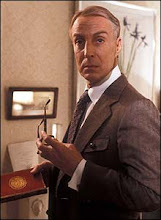Monday, 29 October 2007
Guilty
Back from my school trip. Normandy is one of my favourite places and the weather was stunning: cold and bright with the mist trotting over the gentle valleys each morning. It was, as usual, a fairly exhausting process but I find the Bayeux Tapestry gets more stunning each time I see it, with more ambiguities, more political comment, and more breathtaking action sequences. It helped that the place was empty so for once we could see from a distance, where the cavalry charge sequences look almost cinematic. Some of my charges found pictures of men with their knobs out which I hadn't noticed and was unable to explain unless it was Adam.
I feel as though I need to apologise again to my blogpals for non-appearance at their sites recently. It really is difficult to visit them as often as I'd like because of my dial up and also I'm online a lot less than before, owing to work and a slightly confused home situation (ie I'm in a couple of places). However, I am going to try more to get round.
The title of the post refers really to Engleby by Sebastian Faulks, which I've just finished and which I found less satisfying than his other novels. At times it cannot decide whether it is a murder mystery, a satire or an exploration of consciousness and it ends up being not quite any of them. That's not to say I didn't enjoy it: there is the detail which is characteristic of his work, though it's toned down a bit; there is the Adrian Mole like narrator and the enjoyable hints that the entire thing is made up from much later on (the anachronisms which occasionally creep in, usually from the mouths of other characters). You also sense an author having a lot of fun and letting himself go, whereas his other books feel tightly controlled (especially Human Traces). It's worth a read but you might finish it with a "meh".
I feel as though I need to apologise again to my blogpals for non-appearance at their sites recently. It really is difficult to visit them as often as I'd like because of my dial up and also I'm online a lot less than before, owing to work and a slightly confused home situation (ie I'm in a couple of places). However, I am going to try more to get round.
The title of the post refers really to Engleby by Sebastian Faulks, which I've just finished and which I found less satisfying than his other novels. At times it cannot decide whether it is a murder mystery, a satire or an exploration of consciousness and it ends up being not quite any of them. That's not to say I didn't enjoy it: there is the detail which is characteristic of his work, though it's toned down a bit; there is the Adrian Mole like narrator and the enjoyable hints that the entire thing is made up from much later on (the anachronisms which occasionally creep in, usually from the mouths of other characters). You also sense an author having a lot of fun and letting himself go, whereas his other books feel tightly controlled (especially Human Traces). It's worth a read but you might finish it with a "meh".
Subscribe to:
Post Comments (Atom)







4 comments:
I've only read Birdsong, which is both incredibly sad and erotic.
I really do think we should set aside the time to read. I should do more but there is a dearth of English language bookshops.
Hi, TD. I love the Bayeux tapestry too but have never been fortunate enough to have an uncrowded visit. As for Faulks, I loved "Birdsong" and "Girl at the Lion d'Or" but was unsatisfied with "Charlotte Grey" - too many unresolved issues in it and I didn't think he wrote all that well about women. So I gave up on him after that. You have made me think I should try again, though. TD, we understand and are just pleased to see you when you are able to come by!
i note with interest your comment on the cinematic nature of the images; and i have to say as i looked at the individual scenes i found the proportional relationship used to be quite similar to the shapes used by photographers and cinematographers today.
here's an example of a tapestry scene that appears to be in roughly 2:1 ratio.
the most common film aspect ratios are also more or less 2:1 (1.85:1 and 2.39:1), as is the 16:9 (1.78:1) aspect ratio for hi-def television.
i do also note with interest that some scenes in the tapestry use a 3:1 aspect ratio.
(i didn't count the "above border" and "below border" images in making these measurments, just for the sake of clarity.)
Post a Comment